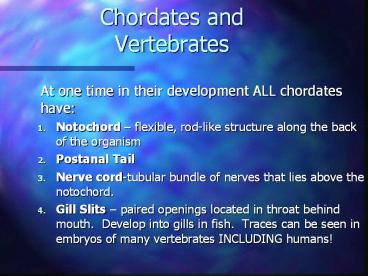Chordates and Vertebrates - PowerPoint PPT Presentation
Title:
Chordates and Vertebrates
Description:
Chordates and Vertebrates At one time in their development ALL chordates have: Notochord flexible, rod-like structure along the back of the organism – PowerPoint PPT presentation
Number of Views:437
Avg rating:3.0/5.0
Title: Chordates and Vertebrates
1
Chordates andVertebrates
- At one time in their development ALL chordates
have - Notochord flexible, rod-like structure along
the back of the organism - Postanal Tail
- Nerve cord-tubular bundle of nerves that lies
above the notochord. - Gill Slits paired openings located in throat
behind mouth. Develop into gills in fish.
Traces can be seen in embryos of many vertebrates
INCLUDING humans!
2
Vertebrates
- Have a backbone that encloses the nerve cord.
- Most are ECTOtherms internal body temp. changes
with its surroundings (fish, amphibians,
reptiles) - ENDOtherms animals with constant internal body
temp. (Birds Mammals) - Endoskeleton internal framework of bone and
cartilage
3
7 Vertebrate groups
- Jawless Fish
- Cartilaginous Fish
- Bony Fish
- Amphibians
- Reptiles
- Birds
- Mammals
4
Fish
- Ectotherms
- Adaptations for water
- Gills- organs for exchanging gas
- Fins fan like structures, used for moving,
balance, and steering - Scales hard thin plates that cover skin,
provides protection - 3 classes Jawless, Cartilaginous Bony
5
Jawless Fish
- Round mouths w/ long, tube-like bodies covered in
slimy skin w/ NO scales. - Flexible bodies made of cartilage.
- EX Lamprey Hagfish
6
Lamprey
HAGFISH
7
Cartilaginous Fish
Skate
difference btw skate ray
- Skeletons made of cartilage
- Movable jaws Scales
- Ex Sharks, Skates Rays
Ray
8
Bony Fish
- 95 of all species of fish
- Gills protected by gill cover
- Swim Bladder
- Most have separate sexes
- Reproduce by females releasing large of eggs,
then males swim over eggs and release sperm.
Call this spawning. - Form of External fertilization
9
3 Classes
- Lobe-finned Fish
- Rayfinned fish
- Lung fish
10
Swim Bladder
- Buoyancy ability of a liquid or gas to exert an
upward force on an object in it. - Swim bladder allows it to adjust its density so
it can rise or sink. - Fills with gas-rises. Deflates-sink.
11
Amphibians
- Ectothermic vertebrates that spend part of their
life in water part on land. - Ex Frog, toad salamander
- Greek word amphibios means double life
12
Amphibian Adaptations
- Respiration
- -Moist, smooth, scaleless skin that allows gas
to be exchanged (breathe through skin) - -Also have small lungs to aid in breathing.
- Hibernation inactivity in winter
- Estivation inactivity in hot, dry summer
months. - Eggs have no shell, so they must return to water
to lay eggs.
13
Difference Between Frogs Toads
- FROGS
- smooth or slimy skin strong, long legs webbed
hind feet two bulging eyes lay eggs in
clusters
- TOADS
- warty and dry skin stubby bodies with short
hind legs Most have glands on their back that
secrete poison - lay eggs in long chains
14
Salamanders Newts
- Long, slender bodies
- Short legs that appear to come straight out of
their side - Often found under dead leaves and rocks during
the day - Often nocturnal, feeding on worms, crustaceans
and insects
Difference btw salamander Newt
15
Amphibian Metamorphosis
-Egg -Tadpole (aka polliwog) spends its time
swimming in the water, eating and growing. Uses
gills to breathe, presence of a tail -Tadpole w/
legs tadpole sprouts legs and arms, head
becomes more distinct -Froglet stage before the
adult frog. Tail is less prominent.
16
Amphibian Metamorphosis
- Metamorphosis the development of an animal from
a larvae into an adult - Amphibians usually complete their life cycles in
two environments - Larvae water
- Adult land
- Rate of metamorphosis depends on species and
nutrients available
17
Reptiles
- Ectothermic vertebrate
- Dry, Scaly skin
- Often show maternal care (take care of eggs or
young) - Ex. Snakes, lizards, alligators, turtles
18
Adaptations for Life on Land
- Thick, dry skin covered with scales
- 4 legs with claws that hold body off ground
(except snakes) - Amniotic egg
- provides environment for embryo to develop
- leathery shell
- Reptiles breathe with LUNGS!
19
3 Orders of Reptiles
- Turtles
- Crocodiles Alligators
- Lizards Snakes
20
Turtles
- Body covered by hard shell on both top bottom
- Most can withdraw partially into shell for
protection - Have a BEAK (no teeth)
21
Crocodiles Alligators
- Crocs
- Long, slender snouts
- Both bottom (4th lower tooth) Top teeth stick
out when jaw closed - Found all over world
- Aggressive
- Alligators
- Broad snouts
- Only top teeth stick out, bottom teeth have spots
to fit in so you do not see them. - Found only in South East USA and China
22
(No Transcript)
23
Lizards SnakesLargest group of Reptiles!
- Lizards
- Moveable eyelids
- External ears
- Legs with clawed toes
- Snakes
- No moveable eyelids, external ears, or legs with
clawed toes - Hear by vibrations picked up by lower jaw bone
24
Venomous vs. Poisonous
- There are NO poisonous snakes!!!
- Only Venomous
- Venom must be injected into the target
- Poisonfound in skin or meatcan cause problems
if eaten or you come in contact with it (ex Dart
frogs)































